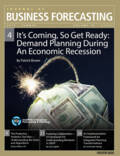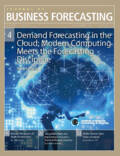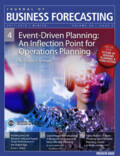 Cart
(0)
Sign In
Cart
(0)
Sign In
- Type of content
- All Knowledge
- Analytics
- Process
- Technology
- People
13
Articles Available
Rapid demand response forecasting techniques are forecasting processes that can incorporate key information quickly enough to act upon in real time by agile supply chains. This makes it the ideal approach to plan demand during the current disruptions caused by Covid-19. Here I present a case study of using these techniques to assist a major online grocer, employing machine learning and advanced analytics to better predict demand. Combining product attribute data, a range of external data, and historical demand proved to be the best approach to predicting changing demand patterns, protecting this company at this difficult time, and giving it a powerful competitive advantage.
Winter 2019-2020
5
With digitalization there is a need to refocus on new demand management technology that utilizes advanced analytics including artificial Intelligence/machine Learning and takes advantage of cloud based open source technology. The next generation of demand management technology will form part of an analytically driven demand planning and forecasting process that provides a platform for business users and data scientists to predict and plan for demand across all time horizons including daily, weekly, monthly and beyond. This will connect all business functions in realtime, enhancing the accuracy of statistical forecasts and the value of demand plans.
Winter 2019-2020
4
This article deals with Artificial Intelligence (AI) technology and its potential role in business decision-making (DM) processes. It addresses whether an AI computer system’s speeding up of processes, approaching real-time decision-making including optimization, will be beneficial. To assess this, it introduces two type types of thinking discussed in the literature. While pre-supposing that AI will surely be useful in a decision support role, it looks at roles it may play in making decisions for the two types, without intervention from managers. Moreover, it warns against using AI output at face-value for the most impactful and strategic decisions to be made.
Winter 2019-2020
3
New planning software can bring about greater forecast accuracy, lower inventory and better service levels. But implementing a new planning solution is a major undertaking, and maximizing the new tools requires an approach that goes beyond the implementation itself. In this article I document 4 common behaviors that can limit the ROI of any software investment, or even lead to abandonment of the software. I provide suggestions on how planners can avoid these behaviors and get the most out of newly available tools, both now and for the long term. Key considerations include post-launch training and managing stakeholders’ expectations.
Winter 2019-2020
3
In this article I aim to help you make the right planning software investment for your company. I discuss how to develop a detailed specification document based on your collaboration, process and functional requirements. Such a document allows you to crosscheck your needs with whatever solution you are considering and helps ensure that any investment serves all internal users of your forecasts and provides an ROI for the long-term. I also reveal the costs of investing in software, and the direct and indirect savings it can provide.
Winter 2019-2020
5
The digital economy refers to an economy that is based on digital computing technologies where business is conducted through online and mobile devices using the internet-of-things (IoT). In the digital economy, value is created through the technology-enabled links between people, machines, channels and organizations. All this is giving rise to an awareness and willingness to apply analytics to everything, not just to strategic initiatives, but to day-today tasks. Advanced analytics aided by machine learning algorithms will automate the repetitive work demand planners do regarding managing data and information as well as uncovering key insights allowing them to work smarter and more efficiently. As such, digitalization of the supply chain will require companies to manage product replenishment based on actual consumption rather than transactions.
Summer 2019
5
There’s a lot of excitement lately about AI, new models, and machine learning algorithms and the accompanying idea that they will replace all human judgement. This misconception may be due to lack of understanding about how all the tools and methods now available fit together, and how we need all of them if we’re to forecast all datasets accurately. In this article we will look at the full spectrum of forecasting methods from pure judgment to machine learning, and classify each of them so that they are easy to understand. I also provide an explanation of each of the broader classes of methods, so demand planners can add different models to their toolkit, knowing when to use which one for maximum effect.
Summer 2019
6
The second machine age is allowing us to understand and shape our environments using computers and other digital advancements. We’re now seeing unsupervised learning systems that learn faster, require less data, and achieve impressive performance. These supervised and unsupervised intelligent automation techniques can drive automation and enrich their domain experts — not replace them by helping them work more effectively. Intelligent automation driven by Artificial Intelligence (AI) and machine learning (ML) are disrupting the way companies do business. The rapid deployment of automation is helping us set new standards of efficiency, speed, and functionality. Intelligent automation will help demand planners to sense and synthesize vast amounts of information boosting the FVA process guiding demand planners with surgical precision to work smarter.
Fall 2018
Cloud computing is slowly but surely establishing itself as the preferred platform and trusted IT operating model. It has both pros and cons, though the advantages far exceed the drawbacks. Through public clouds, organizations can significantly reduce upfront investments in IT, increase and decrease capacity according to their needs and pay only for what they use, and centralize data and systems which can be accessed from anywhere in the world. This will also enhance demand and supply chain planning by offering a platform that can quickly store, process and analyze large amounts of data (both structured and unstructured) to gain insight. However, it is not without risks, which include security, loss of control, and dependencies on cloud providers.
Fall 2018
As forecasters, we continue to look ahead and, to the best of our ability, try to determine what is next. It is only fitting that together we take this view into the next decade, and look at what changes may be on the horizon in our own industry and in the field of forecasting and demand planning. This article, using results from a recent survey of the future of forecasting and demand planning, looks at how people in the field feel about where we are heading, and how we may need to adapt to the next generation of demand planning.
Winter 2017-2018
More than 20 years ago, during my tenure as a consultant with Accenture, I worked on an eye-opening engagement with Limited Brands, a private label apparel retailer. The company engaged us to improve its forecasting capabilities. An executive there believed that its internally developed legacy forecasting computer systems were no longer responsive to changing demand patterns. He wanted us to research what changes needed to be made to the forecasting algorithms it used.
Fall 2016
4
The digital revolution has affected all aspects of business, including supply chains. The Internet of Things (IoT), with its network of devices embedded with sensors is now connecting the consumer to the factory. Technologies such as RFID, GPS, event stream processing (ESP), and analytics are combining to help companies to transform their existing supply chain networks into more flexible, open, agile, and collaborative digital-driven models. Digital supply chains enable business process automation, organizational flexibility, and digital management of corporate assets.
Summer 2016
3
During the past decade there have been major shifts in demand management. Unfortunately, there has been more discussion than actual adoption; where adoption has occurred, there has been little if any sustainability. A demand-driven process is all about dynamic marketplace choices to drive profitability in existing and emerging segments.
Fall 2015
8














